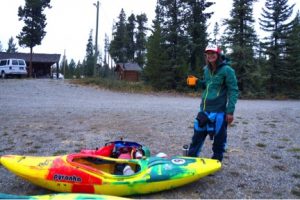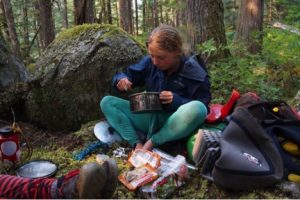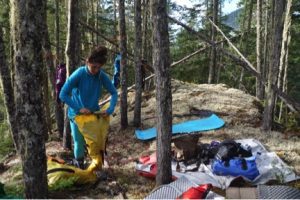Multi-day trips are one of the best ways to enjoy the river. Kayaking all day with friends, camping, and then doing it all over again—what’s not to love! Although river trips are exciting and amazingly fun, preparing for your trip and loading a kayak with days worth of gear can sometimes be a little overwhelming. Here are some tips to make your next multi-day packing experience a little easier.

Jo Kemper getting ready to load her boat on a float plane on the Klinaklini River in BC
Deciding what to bring:
I am a chronic over-packer, so I try to pair down as much as possible while I’m loading my boat. Basically, I try to bring enough base layers and warm clothes that I will be able to change every couple of days, and will have an extra set in case things get soggy. I also like to bring a change of clothes that I only use at camp like a puffy coat (can double as a pillow), a sleeping bag, and light flip flops or crocs for camp shoes. Depending on the weather, I will also pack a tent or light tarp to stay dry at camp.
It can also be really nice to bring a camera to stash in your lap bag along with some other essentials to use during the day, such as a headlamp, hat, toothbrush, and snacks.
Once all of my layers, sleeping gear, and daily essentials are packed, I start to gather my food and cooking supplies.

Darby McAdams testing after a long day on the river
Food:
Food is usually best coordinated with your group of friends who will also be on the river. Typically, I try to skip prepackaged dehydrated meals and bring real food to cook. Unless I’m on a longer trip where weight is a major issue, I always opt for fresh veggies, cheese, and whole foods that will taste great and keep spirits high at camp. Depending on fishing regulations in your area, it can also be really fun to pack a break-down pole in your boat to use at camp. Fish tacos, anyone?
Most importantly, don’t forget to bring dessert to share with friends, and maybe a little whiskey for the campfire.
It’s also important to remember water treatment supplies if you will be paddling on non-potable rivers. Depending on the type of water (silty, clear, etc..) you can choose the most effective purification system for your drinking water. Usually, I use some sterilizing tablets or a jetboil to make sure that my water supply is good to go.

(Maranda Stopol loading her drybags for the day)
Organizing gear in your boat:
I like to try and distribute weight pretty evenly throughout my kayak. I will typically bring 3 drybags: one long stern float style bag, and 2 medium sized bags. The stern float holds my sleeping bag, layers, and some food. On the other side of my stern, I put my foam sleeping pad and another drybag with my stove, food, and other camp items. I try to pack heavier items so they sit right behind my seat—I find that the boat typically paddles better when most of the weight is centered around me. Then I wedge my tent poles or fishing pole along the inside of my stern so it’s cushioned by the drybag and can’t bend. Finally, I pack my lap bag with all of my easy access essentials. I personally don’t like putting a lot of weight in my bow, but it can be great storage for lighter items like tarps, produce/veggies, and a tent fly or sleeping pad.
Finally, loading all of your drybags in your boat can be a little tricky. If you’re really struggling to fit a bag in your stern, try to repack it and shape it a little so it fits the form of your kayak. It can also be helpful to give bags one final shove with your foot to really pack them in there—don’t forget to clip them in once they’re loaded!



